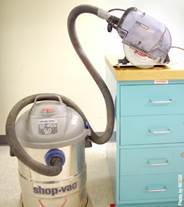
 Attaching a regular shop vacuum to a dust-collecting circular saw can provide a simple, low-cost solution to reduce exposure to hazardous dust produced when construction workers cut fiber-cement siding. The National Institute for Occupational Safety and Health published this recommendation in “Workplace Solutions: Reducing Hazardous Dust Exposure when Cutting Fiber-Cement Siding.”
Attaching a regular shop vacuum to a dust-collecting circular saw can provide a simple, low-cost solution to reduce exposure to hazardous dust produced when construction workers cut fiber-cement siding. The National Institute for Occupational Safety and Health published this recommendation in “Workplace Solutions: Reducing Hazardous Dust Exposure when Cutting Fiber-Cement Siding.”
Fiber-cement siding, a construction material that has grown in popularity in recent years, contains crystalline silica and, when cut, can create fine dust particles that a worker can inhale. Breathing dust that contains crystalline silica can lead to a deadly lung disease called silicosis. While silicosis is preventable, a new NIOSH survey found that about 100 people still die from silicosis each year.
“Our study showed that connecting a regular shop vacuum to a dust-collecting circular saw provides a simple and low-cost solution to the problem of silica exposure from cutting fiber-cement siding,” said the study's lead researcher, Chaolong Qi, Ph.D. “Implementing this intervention, with a tool these workers are already likely to have available to them, can protect workers from a potentially deadly disease.”
NIOSH scientists conducted the research that led to this workplace solution in two phases. First, in a laboratory setting, researchers looked at three dust-collecting circular saws connected to an external vacuum. Findings indicated that the circular saws, used in conjunction with an external vacuum cleaner that had a cyclone pre-separator and a HEPA filter cartridge, removed at least 81 percent of the hazardous dust even with an airflow rate lower than that found in a typical shop vacuum.
To validate the effectiveness of a regular shop vacuum at reducing dust, researchers conducted further studies at construction sites where workers were cutting fiber-cement siding. Results of the field studies showed that a regular shop vacuum controlled the amount of silica-containing dust in the air to well below the NIOSH recommended exposure limit for crystalline silica (0.05 mg/m3).
NIOSH's recommendations to control silica-containing dust when cutting fiber-cement siding include :
- Use a shop vacuum with an airflow rate of 30 cfm or higher with a hose connected to the circular saw.
- The hose used to connect the shop vacuum and circular saw should be 1.25 inches or greater in diameter and should be only as long as necessary and be kept straight.
- A high-efficiency disposable filter bag can be used as a pre-filter in the shop vacuum to capture most of the dust.
- The shop vacuum and circular saw can be plugged into an intelligent vacuum switch, which turns on and off the vacuum and ensures the vacuum is running while operating the saw, avoiding uncontrolled dust release. For shop vacuums that don"t have the switch incorporated in it, an aftermarket device with the same feature can be purchased and used.
- Use only circular saws with a built-in dust collection container or shroud that functions as a hood, partially encloses the saw blade and can easily connect to a shop vacuum.
- Use polycrystalline diamond-tipped blades designed for cutting fiber-cement siding.
“Workplace Solutions: Reducing Hazardous Dust Exposure when Cutting Fiber-Cement Siding” is available at www.cdc.gov/niosh/docs/wp-solutions/2015-185/default.html. To learn more about engineering control solutions for hazardous dust in construction activities, visit www.cdc.gov/niosh/topics/silica/constructioncontrolmain.html.


 Join our thriving community of 70,000+ superintendents and trade professionals on LinkedIn!
Join our thriving community of 70,000+ superintendents and trade professionals on LinkedIn! Search our job board for your next opportunity, or post an opening within your company.
Search our job board for your next opportunity, or post an opening within your company. Subscribe to our monthly
Construction Superintendent eNewsletter and stay current.
Subscribe to our monthly
Construction Superintendent eNewsletter and stay current.